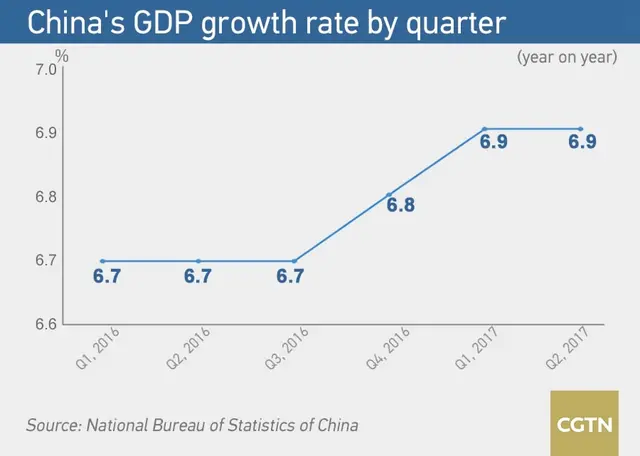Powered by new growth engines and reforms, the Chinese
economy has maintained a strong performance despite downward pressure
and uncertainties.
China's GDP grew by 6.9 percent
year-on-year in the second quarter of 2017, flat from the first.
Compared with the quarterly growth rates of 6.7, 6.7, 6.7 and 6.8
percent respectively last year, the world's second largest economy shows
a more robust momentum this year.
The latest figures released by the National Bureau of
Statistics (NBS) on Monday leave little doubt that China will meet its
annual growth target of "about 6.5 percent."
"I'm
pretty optimistic," Jeremy Stevens, an economist at Standard Bank, told
CGTN. "I don't think growth will go below 6.5 percent for either of the
next two quarters."
Decoding Chinese economy
Stevens called the performance of China's economy in the first half of 2017 "pretty impressive."
This
impressiveness is not only highlighted by the growth rate, but also
achievements in economic restructuring and improvement of people's
livelihood.
The figures show that consumption has contributed more to growth while the service sector has expanded its share in the economy.
In
the first six months of 2017, retail sales of consumer goods grew by
10.4 percent year-on-year, up from 10 percent for the first quarter.
The
service sector grew by 7.7 percent, outpacing a 3.5-percent increase in
the primary industries and 6.4-percent in the secondary industries. By
the end of June, the service sector already accounted for 54.1 percent
of the overall economy.
Some 7.35 million new jobs
were created in China's urban regions from January to June, 180,000 more
than the same period last year, while per capita disposable income grew
by 8.8 percent, higher than the GDP growth rate of 6.9 percent.
According to NBS spokesperson Xing Zhihong, the steady
growth was the result of progresses in supply-side structural reform and
new development concepts.
In a commentary published
on People's Daily's social media account on Monday, reporter Lu Yanan
echoed Xing's words, attributing the impressive economic performance to
the country's new growth engines and deepening reforms.
"According
to estimates by some experts, new engines already contribute to 30
percent of China's economic growth," Lu wrote. "The new engines such as
sharing economy, platform economy and high-tech industries have
activated consumption, boosted job growth and facilitated the upgrade of
traditional industries, becoming the locomotive of the future of
China's economy."
A smooth shift from traditional growth engines to new ones needs more "dividends" of reforms, she added.
Reforms and risks ahead
China's faster-than-expected GDP growth has given policymakers room for deeper reforms, a Reuters article said on Monday.
Chinese
officials will have more room to rein in financial risks by
deleveraging and controlling debt levels, the report explained.
At
the fifth National Financial Work Conference last week, Chinese Premier
Li Keqiang noted that deleveraging should be pushed forward in an
"active yet prudent" way, indicating a fine balance between deleveraging
and maintaining growth.
"Given a reasonably healthy
economy, we will see similarly contractive measures into the future,"
Brock Silvers, managing director of Kaiyuan Capital, told CGTN on
Saturday.
While expressing his confidence that China's economic
performance in the first two quarters "has laid a solid foundation for
achieving the annual target," the NBS spokesperson also warned of
uncertainties and instabilities in the world as well as prominent
long-term structural contradictions at home.
Xing's concern is shared by some economists.
"In
general, we expect GDP growth to remain robust in the second half but
slower than the first half, due to the high base," Citi economists said
in a research note. "Looking ahead, uncertainty remains on investment
and trade."
Chen Yanbin, a researcher at Renmin University of
China, said at an economic forum on Monday that the Chinese economy
would still face downward pressure in the second half of the year.
The
pressure could come from a cool-down of the housing market, a slowdown
of fixed asset investment growth, an increase of production costs for
enterprises, a rise of financing costs for the real economy amid
deleveraging as well as external uncertainties.
Chen
suggested lowering overall taxes for residents and enterprises, which
could further invigorate the economy. He also said a slightly more
relaxed monetary policy could contribute to economic stability.
 简体中文
简体中文



